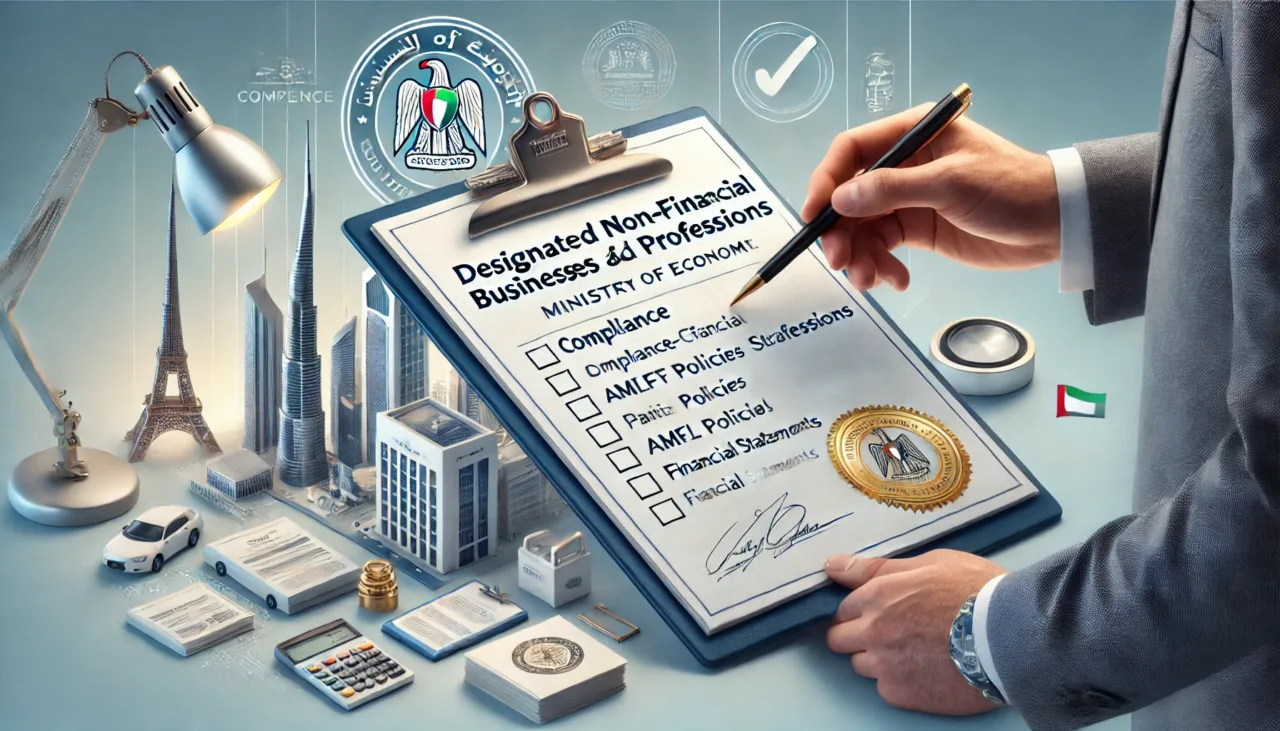When it comes to maintaining compliance within the regulated sectors, staying updated with the inspection requirements is crucial. For Designated Non-Financial Businesses and Professions (DNFBPs), these requirements are particularly rigorous, as they are mandated by the Ministry of Economy (MOE). Inspections can be carried out by the license issuing authority, such as the Dubai Economic and Tourism Department, on behalf of the MOE, or directly by the MOE itself. However, it’s important to note that only the MOE has the authority to impose Anti-Money Laundering (AML) administrative penalties. Any inspection conducted by registrars or other authorities is submitted as a report to the Ministry of Economy, which then reviews the findings and takes enforcement decisions accordingly. In this article, we’ll walk you through the main inspection requirements for DNFBP companies, helping you ensure your business is fully prepared. And remember, if you need assistance, we’re here to help!
1. Company Information
- Documentation: Ensure that your trade license, memorandum, and articles of association are up-to-date.
- Ownership Records: Maintain an accurate register of Ultimate Beneficial Owners (UBOs) and shareholders.
- Organizational Structure: Your company’s organizational chart should clearly define departments and heads.
- Board and Staff Details: Keep a detailed list of board members and staff, including their job designations and nationalities.
- Group Structure: If applicable, provide details of your group structure, including subsidiaries and branches, along with their trade licenses.
- Outsourcing Agreements: If you have outsourced services, ensure all service level agreements are documented.
2. Financial and Banking Information
- Financial Statements: Prepare audited or unaudited financial statements for the last two years.
- Credit Report: A full AECB (Al Etihad Credit Bureau) report as of the current date is required.
- Bank Accounts: Provide a comprehensive list of all bank accounts held by the company, including statements for the last 12 months.
3. AML/CFT Policies and Procedures
- AML/CFT Documentation: Ensure your Anti-Money Laundering (AML) and Counter Financing of Terrorism (CFT) policies and procedures are up-to-date.
- Risk Assessments: Document the entity-wide risk assessment methodology and results.
- KYC Processes: Outline your Know Your Customer (KYC) process, especially for identifying Ultimate Beneficial Owners and Politically Exposed Persons (PEPs).
- Record Keeping: Detail your processes for record keeping and implementing targeted financial sanctions.
4. Compliance Officer
- Details and Documentation: Provide the compliance officer’s details, including their CV and job description.
- Third-party Agreements: If applicable, submit agreements with third-party consulting firms handling compliance.
- Periodic Reports: Include the latest reports from the compliance officer on AML/CFT processes.
- Training Records: Maintain records of training programs related to AML/CFT for employees and management.
5. Risk Assessment
- Comprehensive Risk Assessment: Document your entity-wide risk assessment methodology, along with the latest results.
- Client Risk Classification: Include a list of clients, classified by risk, considering various factors such as geography, products, services, and transactions.
6. Customer Due Diligence (CDD)
- Client Documentation: Ensure all client files include required documentation for CDD/Enhanced Due Diligence (EDD).
- Supplier Records: Maintain KYC files for all suppliers.
- KYC Forms: Keep samples of properly filled KYC forms.
7. Politically Exposed Persons (PEPs)
- PEP Register: Maintain a register of PEPs, including approvals from senior management and related documents.
8. Cash Transactions and Virtual Currencies
- Transaction Records: Keep a list of all cash transactions for the past two years.
- Virtual Assets: If applicable, document all transactions involving virtual assets, including wallet numbers and platform details.
9. Ongoing Monitoring and Transaction Monitoring
- Monitoring Mechanisms: Outline the mechanisms for ongoing transaction monitoring, including red flags and indicators.
10. Reports via GoAML
- Suspicious Transaction Reports: Maintain a list of Suspicious Transaction Reports (STRs) and Suspicious Activity Reports (SARs) submitted over the last two years.
- Freezing and Name Match Reports: Document reports on funds freezing and partial name matches, if applicable.
11. Record Keeping
- Records and Documentation: Ensure you have samples of all files related to financial, commercial, and cash transactions.
12. Targeted Financial Sanctions
- Screening Results: Keep samples of screening results against Targeted Financial Sanctions (TFS) lists.
13. Internal Audit Report
- Audit Effectiveness: Include the latest report from internal or external auditors on the effectiveness of AML/CFT procedures.
14. AML/CFT Training
- Training Programs: List all relevant training programs conducted for employees and senior management.
- Compliance Officer Training: Document the training sessions attended by the compliance officer.
Meeting these comprehensive inspection requirements, as set by the Ministry of Economy, can be challenging, but it’s essential for the smooth operation of your business within the DNFBP sector. Whether your inspection is conducted by the MOE directly or by an authority like the Dubai Economic and Tourism Department, remember that only the MOE has the authority to impose AML administrative penalties. Any inspection carried out by registrars will be submitted as a report to the MOE, which will review the findings and decide on enforcement actions. Our team of experts is ready to assist you in navigating these obligations, ensuring your company remains compliant and prepared for any inspections. Contact us today to learn how we can support your compliance efforts at compliance@integritycorp.ae

